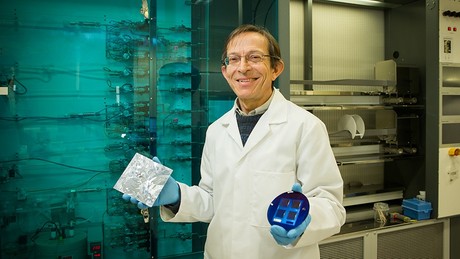Undoped silicon enables cheaper, more efficient solar cells

Australian scientists have developed a new silicon solar cell that could lead to cheaper manufacturing processes and better power output.
Instead of using doping impurities within the silicon structure to control the electronic properties, the scientists sandwiched a silicon wafer between a lithium fluoride layer and a molybdenum oxide layer.
Lithium fluoride has a low binding energy of electrons, known as the work function, while molybdenum oxide’s is very high. The difference means that when sunlight hits the silicon and creates an electron-hole pair, the electron is drawn to the lithium fluoride, while the hole goes the opposite way, which creates an electric current.
In contrast to conventional doped cells that are made at above 800°C, these new cells are manufactured below 200°C. They also do not require the often toxic chemicals used to dope conventional materials.
“For a lot of people this will broaden their idea of how silicon solar cells can be made,” said lead author James Bullock, a PhD student at the ANU Research School of Engineering, who conducted the study while on placement at UC Berkeley’s Department of Electrical Engineering and Computer Sciences. Other scientists from the Australian National University (ANU), Berkeley Lab, UC Berkeley and EPFL participated in the study. The research is published in Nature Energy.
The team’s best solar cell so far has achieved nearly 20% efficiency, which is better than the industry average, said co-author Professor Andres Cuevas, also from ANU Research School of Engineering. “There is nothing to say we can’t get to the world record efficiencies, over 25%, using this approach,” he said.
“This device is the result of a completely new understanding of the physics of solar cells,” said Professor Cuevas.
“All those wonderful materials were sitting there, some of them already in our lab cabinets, but we had not realised how useful they can be.”
Aust solar farms to deploy Canadian anti-hail tech
Australian energy retailer Flow Power is teaming up with Canadian Solar to deploy the...
Praise for Senate committee report into electrification
Rewiring Australia has welcomed a report into residential electrification carried out by a...
Endeavour Energy launches new community battery program
76 new batteries will be delivered across the Illawarra, South Coast, Greater Western Sydney,...




